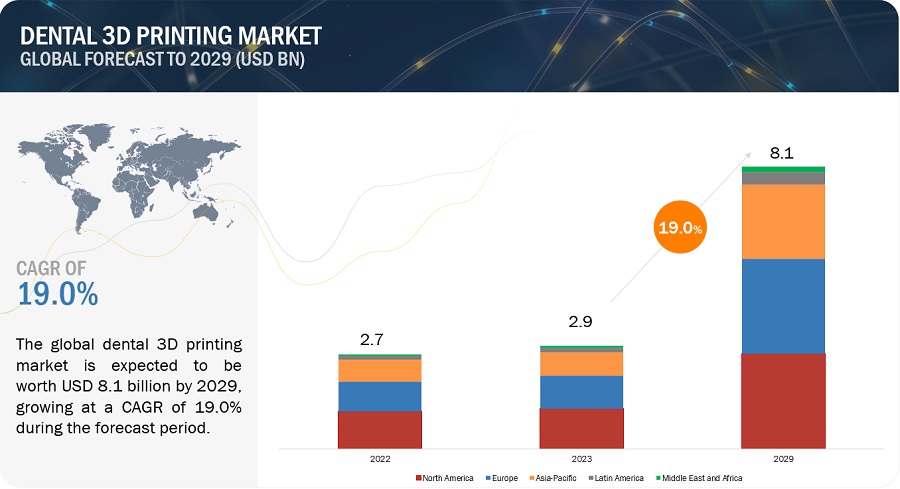The global dental 3D printing market in terms of revenue was estimated to be worth $3.2 billion in 2022 and is poised to reach $7.9 billion by 2027, growing at a CAGR of 20.2% from 2022 to 2027. The new research study consists of an industry trend analysis of the market. The new research study consists of industry trends, pricing analysis, patent analysis, conference and webinar materials, key stakeholders, and buying behaviour in the market.
Market growth is driven by factors such as the increasing incidence of dental caries and other dental diseases, rising demand for cosmetic dentistry, the growing adoption of dental 3D printers in dental hospitals and clinics, and the increasing growth of the geriatric population. On the other hand, the rising number of large dental practices is expected to limit market growth to a certain extent.
Dental caries, or tooth decay, is a common ailment across all age groups, with the global incidence of decayed and missing teeth (DMT) increasing dramatically in recent years.
According to the CDC, in 2019, 64.9% of adults above the age of 18 had a dental examination or dental cleaning procedure. According to the American College of Prosthodontists, more than 36 million Americans are completely edentulous, and around 120 million Americans are missing at least one tooth.

The number of partially edentulous patients is expected to increase to more than 200 million Americans in the next 15 years. Single crowns to replace a missing tooth were the most common restorative procedure; according to the American College of Prosthodontists, 2.3 million implant-supported crowns are made annually.
Download PDF Brochure @ https://www.marketsandmarkets.com/pdfdownloadNew.asp?id=258228239
“The dental laboratories segment accounted for the largest share of dental 3D printing market in 2021”
Based on the end user segment, the market is segmented into dental laboratories, dental hospitals & clinics, and dental academic & research institutes. In 2021, the dental laboratories segment accounted for 78.6% of the dental 3D printing market. The large share of this segment can be attributed to the increasing number of dental laboratories, expansion of dental laboratories in developing countries, rapid adoption of advanced technologies by small and large laboratories across the globe, the outsourcing of certain manufacturing functions to dental laboratories, and the rising demand for customized/fabricated dental framing solutions required for various applications.
“North America accounted for the largest share of the dental 3D printing market in 2021”
In 2021, North America accounted for the largest share of 35.8% of the dental 3D printing market, followed by Europe, the Asia Pacific, and Latin America. The large share of the North American market can be attributed to the high and growing incidence of dental caries and tooth loss, the rising geriatric population, high oral care expenditure, increasing demand for cosmetic dentistry, and the rising popularity of digital dentistry. However, the Asia Pacific region is projected to grow at the highest CAGR of 22.6% during the forecast period. The growing geriatric population, increasing demand for digital dental solutions to ease the clinical workflow, growing dental tourism, rising disposable incomes, and the growing focus of leading market players on expanding their distribution networks in the emerging APAC countries drive market growth.
Key Market Players :
The prominent players in the global dental 3D printing market include Stratasys (US), 3D Systems (US), Roland DG Corporation (Japan), EnvisionTEC US LLC (Germany), DWS Systems SRL (Italy), Align Technology Inc. (US), Formlabs (US), Prodways Group (France), SLM Solutions (Germany), Carbon, Inc. (US), Concept Laser (Germany), EOS GmbH (Germany), Rapid Shape GmbH (Germany), Asiga (Australia), DENTSPLY Sirona, Inc. (US), SprintRay, Inc. (US), Zortrax (Poland), Detax Ettlingen GmbH (Germany), DMG America (US), 3Dresyns (Spain), Micron Dental (US), Amann Girrbach AG (Austria), Carima (South Korea), Planmeca OY (Finland), and Shenzhen PioCreat 3D Technology Co., Ltd. (China).



